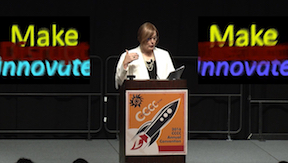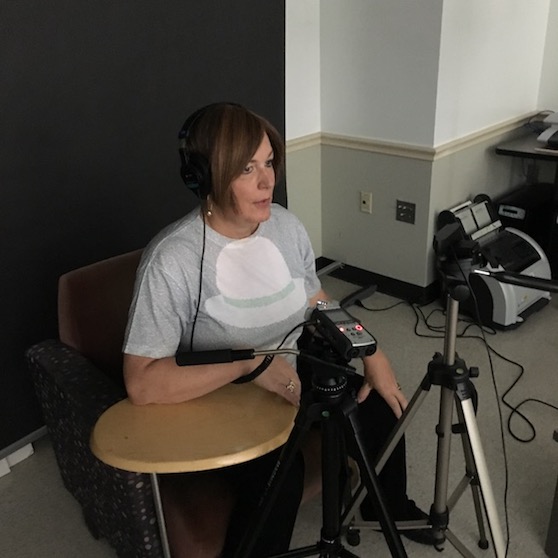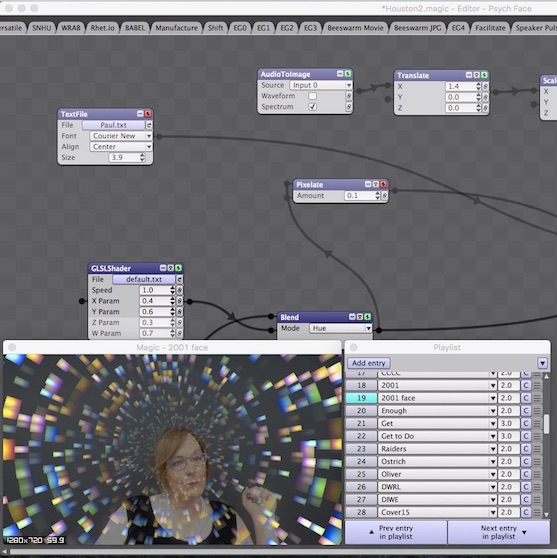
The final remediated video of "Making, Disrupting, Innovating"
The content and delivery of Joyce's 2016 Conference on College Composition and Communication (CCCC) Chair's Address was inspired by a variety of media and experiences: punk music, her experiences at concerts, the history of making in computers and writing and technical communication, the maker movement, and, of course, previous Chairs' Addresses.
As we explained briefly in the introduction, during her talk, Joyce projected visuals on the two screens that flanked her on the stage in Houston. While the visuals in the second half of her address were fairly traditional—images and screenshots that provided examples of making in the field—the visuals during the first half of her address responded to the audio in the auditorium (mostly Joyce's voice, but also applause and other ambient sounds). Joyce used Magic, a music visualization software often used by DJs, to project audio visualizations. In some moments, a live video of Joyce, captured by a webcam sitting on the podium, was projected on the screens; in these moments, Joyce’s face was distorted in response to the sounds of her voice. In other moments, Joyce projected words that moved and danced as the sounds in the auditorium changed. In other moments, the audio was visualized using audio waves and other effects.
The three gifs below exemplify the sorts of disruptive visualizations seen during the address (they are recreations composed in the Media Lab at Texas Tech). Hover over the static image to play the gif file or click on it to open it in a new tab.
Shortly after CCCC, Michael interviewed Joyce at Funky Door, a local restaurant in Lubbock, Texas, for his podcast Red Rhetor (Faris, 2017). During this conversation, Joyce explained her invention process and the inspirations and motivations for her address. As she narrated, some of the inspiration for her delivery came while riding in a Land Cruiser, listening to French punk music, while in Africa. (Note: the background music is a bit loud during this conversation.)
[Live music in the background]
Joyce: I'll tell you exactly where I started putting pen to paper. I was sitting in the far back seat of a Land Cruiser, a safari vehicle. I was in Botswana. It was zipping down the—not zipping—it was in the Kalahari Sands. We were going along, and I was sitting in the far back seat listening to French punk music. And the wind was in my hair. And the great smell of the sage that's all in the African desert. And I just felt—and there's wind in my face—I felt so alive and so full of possibility that I said, This is what I want the speech to feel like. I don't know what it's going to say, but I want this feeling. So I got my little black book out and I started writing, just about that.
In another moment of the interview, Joyce detailed her tendency towards minimalism when it comes to showing visuals during presentations, typically only using images or slides with very few words. But her Chair's Address seemed like a different occasion than her previous presentations. As she was considering what exactly to project during her address, she became inspired by visualizations she saw at a concert:
[live music in the background]
Joyce: Somehow in my mind that I thought, You could use visualizations. Like sometime after ACL [Austin City Limits]—ACL doesn't do visualizations. They just do multiple camera shots on the big screen so you can see. So I thought we could do that, that's just looking at me. There's nothing to look at. But then I was watching a… like in October, maybe when I got back, it was something on HBO and it was the Who in Hyde Park. And they had tv screens. But that was actually not what ACL did. It was a lot of visualizations. It was using video feeds that were through a ripple effect or a number of things.
Michael: Yeah.
Joyce: So I said, that's actually really interesting. And about the same time I began thinking about the theme. So disruption wasn't it. I was using "creative destruction," which is economist [Joseph] Schumpeter's term. I didn't want to use destruction, so I started using disruption. A little bit business-y jargon, but less frightening than destruction. So I thought, so what if you disrupt something, it doesn't matter if you see the guitar or the face. The idea is that you're supplementing and augmenting this experience with something different.
As Joyce explained, her idea with using audio visualizations was to supplement the audio of her voice and disrupt audience expectations with "something different."
Unfortunately, when Joyce received the video file of her address from the National Council of Teachers of English (NCTE)—mailed to her on an external hard drive—she found that the video stopped abruptly with the last few minutes of her talk left out. Further, the video was a straightforward shot of Joyce at the podium that didn't include the screens with her visualizations. Rather than just post the partial video of the talk online, or forget about having a publicly available video at all, Joyce decided to ask Michael and the Texas Tech University English Department Media Lab for help in remediating the video.
We shot the whole speech a second time in the Media Lab: Joyce sat in front of a black screen, and we placed her webcam in front of her for close-up shots. As Joyce read her talk again, Michael coordinated the visualizations on his laptop using Magic and the webcam. We connected Michael's laptop to the television screen in the Media Lab and recorded the visuals using QuickTime. Additionally, we set up a Zoom H4N 4-Channel Handy Recorder in front of Joyce to capture new audio.



Michael suggested that remediating the address for a video would be a good project for graduate students in his May Seminar New Media Rhetoric course. Texas Tech's online Technical Communication and Rhetoric PhD program has a residency component: Every May, online students from throughout the country (and sometimes the world) come to Lubbock for our two-week May Seminar. Students stay in a hotel, attend professional development workshops, have their annual reviews, give presentations on research, and attend lunch talks given by faculty and guest speakers. First- and second-year PhD students take an intensive course for four hours a day. That year, first-year PhD students were taking New Media Rhetoric, a course that introduces students to theories and practices related to composing with and in new media.
So we decided to make remediating Joyce's address one of the options for students' projects during this two-week period. Sarah and Erica volunteered, and we provided them with the raw digital materials we had assembled:
Joyce and Michael provided some constraints and expectations for Sarah and Erica. First, they asked that the video be engaging for an online audience and give a sense of how Joyce disrupted traditional visualizations in her talk in Houston. We didn't want a simple recreation of the live address—that is, Joyce in the center of the frame with two smaller videos just reproducing her visualizations on either side of her throughout the video. Second, because the video from Houston cut off the last few minutes of her talk, we requested that Sarah and Erica adjust the audio, likely using the audio from Houston and then transitioning into the audio we recorded in Lubbock. Because these two audio files were recorded with different equipment in different environments, the audio quality was not the same in the two files.
Third, because Joyce opened and closed her talk in Houston with some punk music (the Ramones's 1976 "Blitzkrieg Bop" and Green Day's 2004 "American Idiot," respectively), and referenced punk in her talk, we asked that Erica and Sarah find some punk music that could be used ethically and legally in the online video version. Lastly, because editing the video would involve editing and splicing together multiple video files, audio files, and images, we suggested using Adobe's suite of video and audio editing software, Adobe Premiere Pro and Audition.